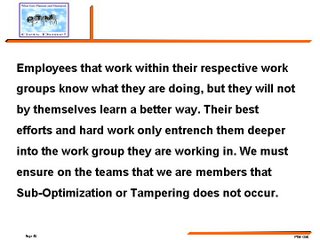ESTABLISHING METRICS
 Determine the following:
Determine the following:
• Purpose/Mission of Process or WorkTeam
- Created by Executive Process Owners
- How it was formed & members chosen
The first team meeting should lay the foundation for how the group will set and achieve their goals.
TO DO
• Define goals of group • Location of meetings
• Roles and Responsibilities • Frequency of meetings
Process Owner:• Is accountable for the quality of process output.
• Is responsible for results of the process.
• Has the authority and ability to make changes.
• Can allocate resources (people, time, money, equipment).
• Is responsible of satisfactorily carrying out ownership roles and responsibilities to handling other priorities.
• Appoints sub-process owners.
• Exercises authority to effect change.
Project Leaders:• Plan and schedule meetings.
• Communicate teams activities & progress to Process Owners.
• Keep team focused.
• Responsible for the integrity of all data used in setting up measurements.
• Provide expertise on process improvement activities.
• Provide technical assistance with process improvement tools and techniques.
• Assist in determining and developing operational measurements.
Team Members:• Be the subject matter experts on, and represent, your Operations area.
• Communicate with appropriate Operational employees to collect data and implement customer focused measures.
• Collect and analyze data for measurements.
• Identify appropriate Operations employees to monitor and measure data on an ongoing basis.
• Actively participate in team meetings.
METHODOLOGY FOR DEFINING AND ESTABLISHINGCUSTOMER
FOCUSED MEASUREMENTS
Measurements should track how well our processes are performing according to:
• Customer Expectations (inc perception) • Organization Objectives
• Customer Satisfaction • Value Drivers
• Competitive Benchmarking • Employee Satisfaction
The above stated types of measurements will help determine the overall quality, efficiency, and effectiveness of all processes.
The activities involved in defining and establishing measures include:
1. Determining effective measures
2. Reviewing and validating existing measures
3. Implementing new measurements
4. Install a measurement and reporting system
5. Establish a feedback and monitoring system
6. Monitor measurements
1. DETERMINING EFFECTIVE MEASURES
Purpose:
Effective measures provide an insightful means about the efficiency of a process. Measures of this type are meant to track and align performance (process) and results (quality) indicators of a business process.
Establishing Effective Measurements:
Create effective measurements based upon the following:
• Customer expectations/requirements
• Practical to implement
• Easy to comprehend
• Consensus of agreement by group
• Able to help drive culture change
What to Measure:
Establish measurements based upon customer expectations and business objectives. These measurements should measure what our customers care about and what will drive our Value Drivers toward exceeding Operational business objectives.
Develop objective measures of customer satisfaction. Without measures, we have no means by objectively assessing the magnitude by which our processes are performing to customer and business requirements, and whether or not our improvement efforts and newly implemented systems have improved the process.
These types of measurements should provide objective data that will drive decisions that will produce long-term customer preference.
If suppliers are included, be sure to measure input characteristics and services.
How to Measure:
Implement simple, easy to understand measurements whenever possible. Measurements that are complex will not be used.
It is vital that our measurements be easily defined, understood and communicated to assure common understanding.
A small amount of meaningful measures are worth 10 times more than a large amount of nice to know measures (non-value added).
It's OK to experiment with measures, if they don't tell you what you need, stop measuring and create new ones.
If at the beginning measured identification is difficult, start with customer satisfaction, every major process has a customer.
Don't just measure one aspect of a process. Yur measurements should be balanced with variable, attribute and some subjective characteristics like time, cost, quantity and customer perception.
Evaluating Measures:
In the beginning it might be best to implement a few strategically based measurements. As stated before, it's best to experiment and monitor the effectiveness of few, rather than implementing a large amount and never monitor.
2. REVIEWING AND VALIDATING EXISTING MEASUREMENTS
Purpose:
Once we've identified and understood what makes effective measurement, it is necessary to assess measurements that are already in place. Effective measurements provide input data that drive motivation for continuous improvement. Those that do not measure up should be changed or eliminated.
Measurement Balance:
If current measurements are only measuring internal business objectives, move to measure the effectiveness of our processes or solutions from a customer perspective.
Measure Behavior:
Implement measures that level to desired behavioral results. Verify the measures do not drive undesired behavior by our workers or to your customers. For example, many companies have found that they speculated "speed of answer" as a desirable measurement for customer satisfaction. Customer survey and interviews found that quality of service provided was more important than speed of answer.
3. IMPLEMENTING NEW MEASUREMENTS
Purpose:
It is vital that any new measurements implemented are effective and efficient and that it is collected, analyzed, and used in a way that motivates positive behavior and not punitive threats to workers.
Data Collection:
Make sure those responsible for collecting or installing new measurements are familiar with data and are part of the implementation plan.
4. INSTALL A MEASUREMENT AND REPORTING SYSTEM
Purpose:
Installing a measurement and reporting system requires an action plan of implementation that identifies the roles and responsibilities of the Process Owner and Sub-Process Owners who will be accountable for the measures.
This also requires agreement on what measures will be reported and that method and system support is available. The Action Plan must include trend analysis and plans of who will respond to them in a timely basis.
Automation:
Whenever possible and cost effective, automate as many measurements as possible. The advantage is more accurate and timely data collection and analysis.
Share Measurements:
Post measurements data in visible places, so that results can be shared by workers in the process. It's also a good idea to keep everyone in the process informed from end-to-end.
5. ESTABLISH A FEEDBACK SYSTEM
Purpose:
By establishing a feedback system, employees will keep abreast of changing expectations and update the current process as required.
Sharing Feedback:
Corporate Quality, Marketing, Sales and Front Line customer facing employees must keep upper management aware of changing customer needs so that business objectives and measurements may be changed accordingly.
It's also important to share feedback with workers in the process as well as customers and suppliers.
6. MONITOR MEASUREMENTS
Purpose:
Employees identified as measurement owners must constantly evaluate their measurements, reassess customer needs, and continuously search for new ways to use data for continuous improvement.
Evaluate Measurements:
If your measurements are not accurately reflecting process performance or drive undesirable behavior, they should be removed. Update or install new measures as needed.
Benchmark Measures:
Benchmarking yuour process measurement performance relative to your competitors will be vital to competition. Benchmarking provides information to leaders that helps establish performance targets based on data from the marketplace. Benchmaring is a useful method to supply additional data and information but not to be used exclusively for changes or measurements.







